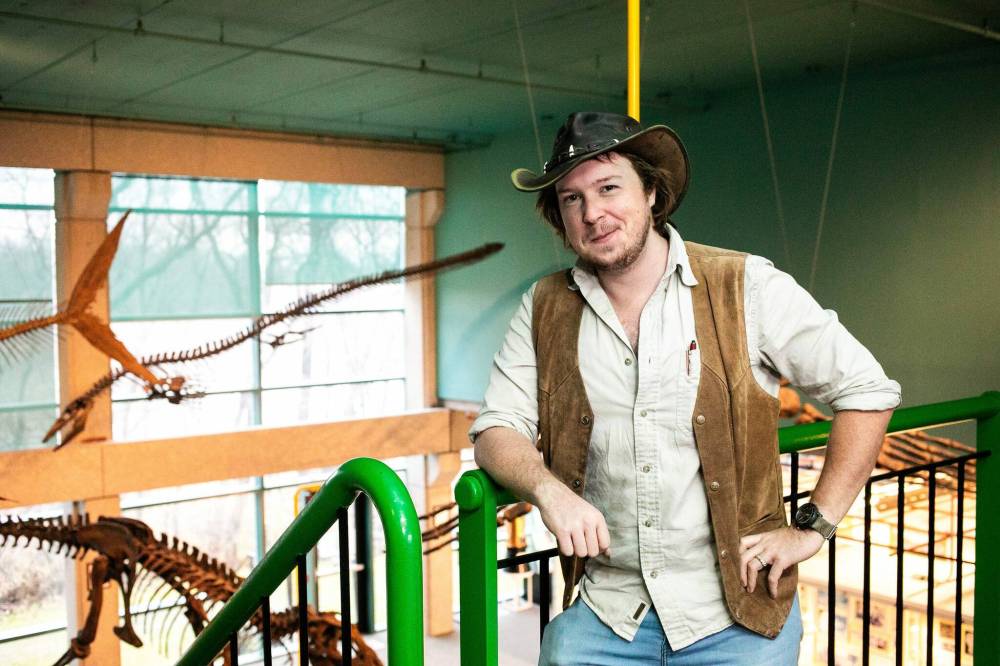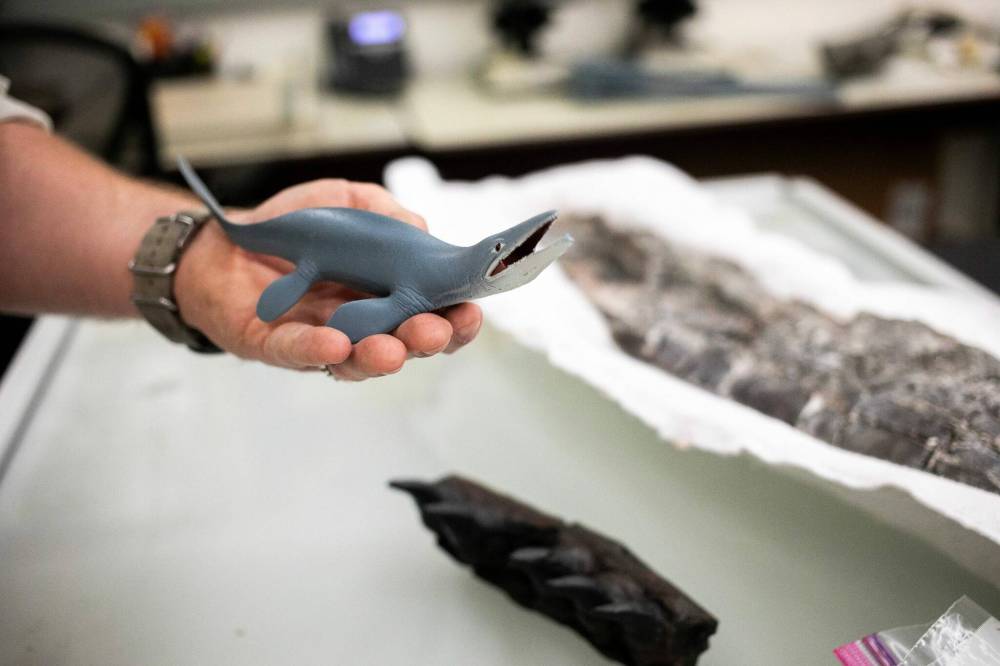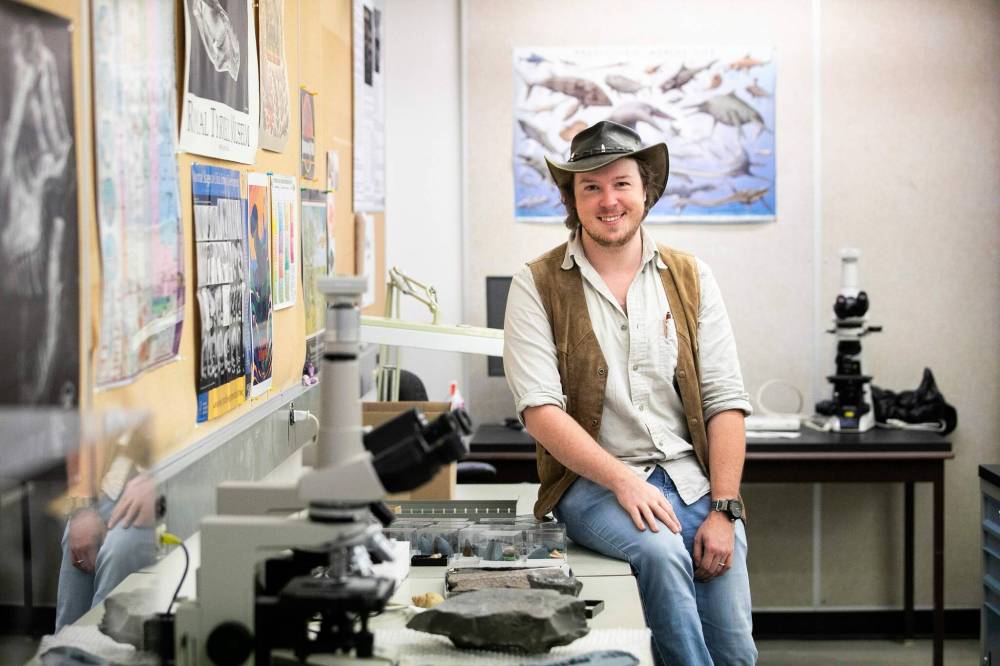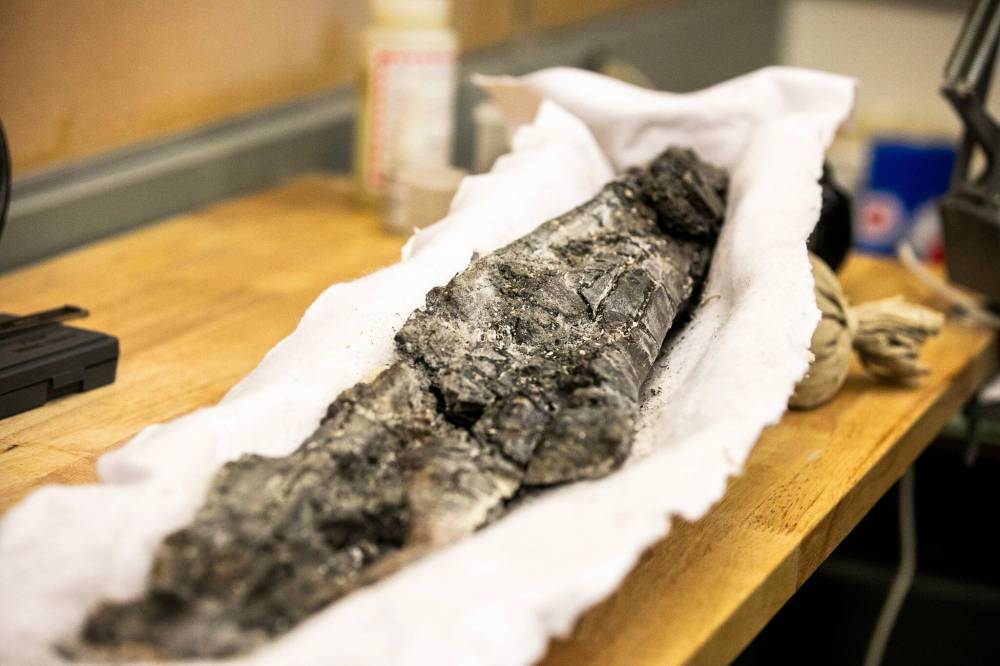In step with dinosaurs Paleontologist makes strides toward understanding the way mosasaurs behaved
Read this article for free:
or
Already have an account? Log in here »
To continue reading, please subscribe:
Monthly Digital Subscription
$0 for the first 4 weeks*
- Enjoy unlimited reading on winnipegfreepress.com
- Read the E-Edition, our digital replica newspaper
- Access News Break, our award-winning app
- Play interactive puzzles
*No charge for 4 weeks then price increases to the regular rate of $19.00 plus GST every four weeks. Offer available to new and qualified returning subscribers only. Cancel any time.
Monthly Digital Subscription
$4.75/week*
- Enjoy unlimited reading on winnipegfreepress.com
- Read the E-Edition, our digital replica newspaper
- Access News Break, our award-winning app
- Play interactive puzzles
*Billed as $19 plus GST every four weeks. Cancel any time.
To continue reading, please subscribe:
Add Free Press access to your Brandon Sun subscription for only an additional
$1 for the first 4 weeks*
*Your next subscription payment will increase by $1.00 and you will be charged $16.99 plus GST for four weeks. After four weeks, your payment will increase to $23.99 plus GST every four weeks.
Read unlimited articles for free today:
or
Already have an account? Log in here »
Hey there, time traveller!
This article was published 20/01/2025 (312 days ago), so information in it may no longer be current.
Maximilian Scott is a vertebrate paleontologist who focuses on extinct animal behaviour and behavioural evolution. Scott, 27, from Ovid, Mich., is in the last year of his master’s degree at the University of Manitoba studying mosasaurs, an ancient marine lizard that lived in Manitoba during the late-Cretaceous period.
He also offers tutoring in geology, biology, animal behaviour and conservation to people of all ages. You can find him on Instagram.
Our story doesn’t start with the first book that was written, our story starts a long time before that, a long time before the first humans. It’s all one long story.
MIKAELA MACKENZIE / FREE PRESS Vertebrate paleontologist Maximilian Scott is researching how the mosasaur, a huge aquatic lizard from the late-Cretaceous period, may have behaved.
Humans have only existed for 200,000 years. The Earth has been around for 4.5 billion years. Life has been around for three billion years, and complex life has been around for 542 million years.
By profession I am a paleontologist, but I identify as a naturalist. I would like to find a way to apply paleontology to conservation.
Paleontology is the study of life in the past. In particular, the prehistoric past. Life before humans started making records. It starts about 10,000 years ago and goes back to the beginning of life.
I study the behaviour and fossil records of tetrapods, four-limbed animals that are not human. I specialize in mosasaurs that lived in what was called the Western Interior Seaway, a shallow sea that once split the north American continent in half from the Gulf of Mexico up to the Arctic Ocean.
In Manitoba there is the Pierre Shale Formation, which is one of the best formations of rocks to find mosasaurs in. There are so many mosasaur fossils here.
MIKAELA MACKENZIE / FREE PRESS A model of a mosasaur.
I have a lot of side projects. I am also studying a turtle, called stylemys, that mostly lived in the Great Plains region of the United States about 30 million years ago. I am describing a new plesiosaur from northern Alberta; I am comparing the brain cases of several ceratopsian dinosaurs based on a new CT scan of a brain case of a pachyrhinosaurus, also from northern Alberta; and I am studying the competition behaviours in sabre cats and other feliforms with sabre teeth.
I wanted to be a paleontologist since before I can remember. I grew up in the days when Animal Planet was actually about animals. My personal icon was Steve Irwin and I watched a lot of Bill Nye and The Magic School Bus. I benefited from being a part of the generation exposed to a lot of science and nature programming.
My love and my passion for the Earth doesn’t stop at paleontology. I have a strong appreciation for the planet we live on and its entire history as this one comprehensive thing we are all a part of.
The past is the key to the present and the present is also the key to the past. I would like to use evidence from the past to predict how we can protect the future.
There is a lot of misinformation about climate change. People will make the point that the climate has always been changing. That is very true: the climate has fluctuated a lot through Earth’s history. But not this fast. The problem is that animals, plants and other organisms cannot evolve fast enough to keep up with how quickly the climate is changing.
MIKAELA MACKENZIE / FREE PRESS Scott believes Jurassic Park could never happen. A T-Rex will never be brought back, because they are simply too old, he says. DNA is not a stable enough molecule to survive for 66 million years.
As far as geologic evidence goes, the last time climates changed this quickly and drastically over such a short period of time was during the Permian Extinction Event.
It was the largest extinction event in Earth’s history. About 95 per cent of all life on Earth ended up going extinct over the course of one million years — that’s considered relatively quick. We are doing it a lot faster and it comes down to human activity.
A company called Colossal Biosciences is working to bring back some of the Pleistocene megafauna animals that more recently became extinct by potentially cloning woolly mammoths, Tasmanian tigers and some other animals caught in the permafrost by using their preserved DNA. (The U.S. startup has so far received US$435 million in funding to support its efforts.)
They have already brought the black-footed ferret from the brink of extinction. The black-footed ferret had dwindled down to the point where there were only 14 individuals. They were the most endangered animal in North America. Now, thanks to cloning efforts, there are more than 500 individuals.
MIKAELA MACKENZIE / FREE PRESS The fossilized jaw of a tylosaurus.
Jurassic Park could never happen. You are not talking about bringing back something that is going to run around and eat people. A T-Rex will never be brought back, because they are simply too old. DNA is not a stable enough molecule to survive for 66 million years.
People focus on climate change like it is the only concern. It’s one of the worst things but it is not the only thing going on right now. Habitat destruction is a huge problem; we are very wasteful as a species in how we use land.
Agriculture is the No. 1 cause of habitat loss. We need to change how we go about agriculture. We should find a way to build our farms upward instead of outward so we use less native habitat in farming areas.
In our entire existence we have been driving things extinct. We are doing it worse than ever now. We don’t have the singular right to just take and give nothing.
MIKAELA MACKENZIE / FREE PRESS Scott handles the fossilized jaw of a tylosaurus (a type of mosasaur) jaw in the University of Manitoba paleontology lab.
We have changed the world in a way no species ever has. We are intelligent, we live for a very long time, and we are very social. We got lucky; those three traits combined allowed us to do everything we’ve done.
We would stop justifying all the destruction we’ve caused if we stopped seeing ourselves as so special. We have deified ourselves as if we are separate from all other animals, but if you look at the grand scheme of life, we are a blip.
We will inevitably go extinct. It’s a matter of when, but that is hard to predict. It depends on what we do and it depends on how responsible we decide to be.
We are more likely to last a long time if we can find a way to live with our planet instead of living against it.
Answers have been edited for length and clarity.
av.kitching@freepress.mb.ca

AV Kitching is an arts and life writer at the Free Press. She has been a journalist for more than two decades and has worked across three continents writing about people, travel, food, and fashion. Read more about AV.
Every piece of reporting AV produces is reviewed by an editing team before it is posted online or published in print — part of the Free Press‘s tradition, since 1872, of producing reliable independent journalism. Read more about Free Press’s history and mandate, and learn how our newsroom operates.
Our newsroom depends on a growing audience of readers to power our journalism. If you are not a paid reader, please consider becoming a subscriber.
Our newsroom depends on its audience of readers to power our journalism. Thank you for your support.
